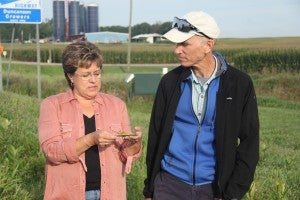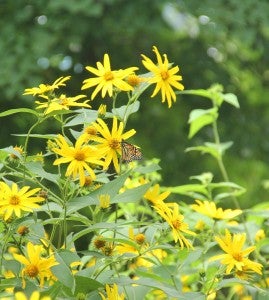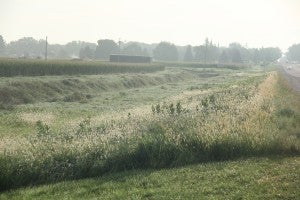
Kristin Duncanson holds a monarch caterpillar we found on her farm. “Everyone has a monarch story,” she said.
Duncanson Growers is a family farm located in the heart of southern Minnesota. Owners Kristin and Pat Duncanson produce pork and grow corn, soybeans and vegetable peas on the farm, with a commitment to sustainable practices that improve the quality of their land. But it’s not just about environmental sustainability.
“We also need to maintain and increase our productivity to be economically sustainable,” Kristin said.
The Duncanson family has been committed to sustainability not only through their own farming operations, but also through outreach and education efforts. I recently paid a visit to the family’s farm, where just the night before they had hosted 30 college students for dinner, recognizing the importance of communicating their sustainability practices to others.
In addition to their current practices, which include improving data collection to increase fertilizer efficiency, reducing tillage where possible and rotating crops, the Duncansons have also maintained some very high quality habitat for monarch caterpillars and butterflies.
The Duncanson monarchy

A monarch butterfly rests on a sunflower at the Duncanson family farm.
Kristin and Pat have always taken note of the iconic orange and black butterflies that roam about their property. They pointed them out to their children when they were growing up and they continue to appreciate their presence on the farm.
The Duncansons are also aware of the milkweed plants scattered about the farm in field ditches and along road sides. Monarchs need milkweed to lay their eggs, and their caterpillars feed exclusively on milkweed leaves. Kristin told me how she loves the site of milkweed seeds floating in the wind, attached to tufts of white fluff.
By leaving these milkweed patches alone at critical times for monarchs, Kristin and Pat are maintaining vital habitat for monarchs.
When I visited the Duncansons a few weeks ago, I got to witness firsthand a plump caterpillar munching away at a milkweed leaf. At this time of year, any caterpillars found as far north as Minnesota are fourth generation monarchs – ones that migrate all the way to Mexico to overwinter in the oyamel fir forests.
The butterfly effect

We found hundreds of milkweed stems in this roadside water retention ditch – a common place to find native milkweed on farms.
The Duncansons are somewhat unique in their multiple and steadfast commitments to conservation, but they are not unique in their admiration for monarchs. Many farmers across the United States have noticed that fewer and fewer monarchs return to their farms each year, and they recognize the essential role that agriculture plays in conserving the species, whose population has dropped by more than 90 percent in 20 years.
That’s why most of the farmers and ranchers I’ve met have been just as excited about the Monarch Butterfly Habitat Exchange as Kristin was. By offering additional incentives for producers to actively maintain and create habitat for monarchs, the exchange opens the door to millions of acres of untapped potential for conservation on American farmland.

Dr. Karen Oberhauser of the University of Minnesota Monarch Lab joined us to test the Habitat Quantification Tool at the Duncanson’s property.
While at the Duncanson farm, I was joined by colleagues from Environmental Defense Fund, Environmental Incentives and the University of Minnesota’s Monarch Lab to test the Habitat Quantification Tool currently under development. This tool, once sufficiently tested, will be the basis of the Monarch Butterfly Habitat Exchange. It will assess a property’s habitat value for monarchs so incentive payments can be directed to landowners who protect or enhance the site.
I’m very excited about the potential to begin working with more producers like the Duncansons to combine their conservation ethic (not to mention love of monarchs) with cutting-edge tools and programs to create a winning solution that will benefit both farmers and butterflies.
Related:
What would it take for a Nebraska corn farmer to grow milkweed for monarch butterflies? >>
Why two California farms give me hope for the monarch butterfly >>
Monarch butterflies get help from Texas ranch >>









